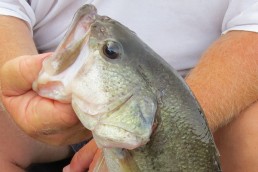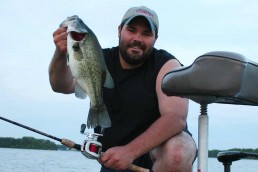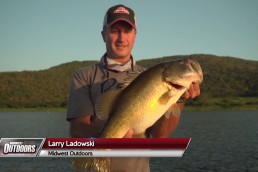Find Suspended Bass Over Deep Water
SHARE THIS POST
Most fishermen prefer to pursue Largemouth and Kentucky Bass in the spring, when their patterns are more predictable. But they don’t just disappear after the spawn; they move to deeper water.
Keep in mind that the bass do not suspend in open water in the middle of nowhere. They usually can be found at the end of a deep point, a channel, ledge, sunken island or whatever underwater structure they can find.
Largemouth bass do not want to stay in open water. They prefer the shoreline or on emergent structure. But temperatures in late summer force them to find a place in the water column that is more comfortable. On larger bodies of water, this can present quite a challenge.
Suspended fish in open water are very difficult to catch. It’s best if one follows whatever underwater structure available, and traces it back toward the shoreline. Chances are good that some of those fish are moving back, looking for something to eat–which makes them vulnerable to lures.
You may find a concentration of inactive fish off shore in which a few move back and forth to feed. If the weather and feeding conditions are prime, than many will make the move toward the shore. In hot weather, they remain in deeper water during the day and come into the shallower water as it cools during the night.
In late summer, the schools of bass that are feeding on forage fish will respond to lipless crankbaits that provide noise.
An interesting study done a few years ago by Cetacean Research Technology in Seattle opened some new views into bass behavior. We had long known that bass respond to noise but just why—and what noise—was not clear.
Are you enjoying this post?
You can be among the first to get the latest info on where to go, what to use and how to use it!
The study found that the noise from a lipless crankbait is nearly the same as that made by a schooling shad. Bass and other game fish return to feeding activity by this sound.
Some fish will respond to small, shad color topwater baits and shallow running lures.
That said, there will be times when the bass just seem to reject any presentation. This is when one should consider lure size. Try downsizing the weight of the lure. In the fall, they may be feeding on very small shad and a lure as small as ½ inch in length might be just the ticket.
Schooling usually takes place in open water. The key to catching schooling fish is matching the size of the lure to the size of the forage fish; the larger bass herd the forage fish to the surface and then strike them in a feeding frenzy. A lure should imitate the wounded forage fish that were victims of the drive.
After the foraging frenzy is over, the bass return to structure in the area and hole up until their next meal. An electronic fish locator will often lead you to some major structure.
Often, they can be enticed out of seclusion with jig and minnow, grub, or spoon lure.
On larger bodies of water, as well as in deeper water, bass will be found near any structure. The fishing becomes more erratic as the water cools. Nevertheless, during the feeding frenzy periods, there’s great fishing action—so don’t give up on the bass fishing just because the spawn is over.
MWO
SHARE THIS POST
Did you enjoy this post?
You can be among the first to get the latest info on where to go, what to use and how to use it!
Don Gasaway
Don Gasaway is a veteran freelance outdoor writer from Marion, Ill. He may also be found at: https://www.facebook.com/DonGasawayWriter and facebook.com/Wandering Angler. Comments are welcome



